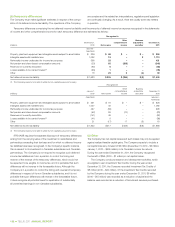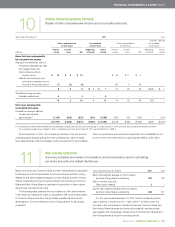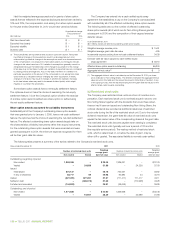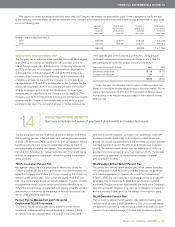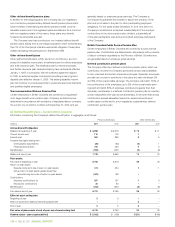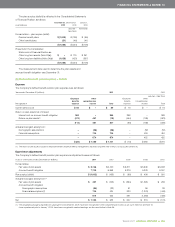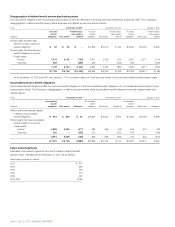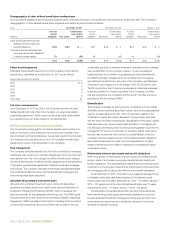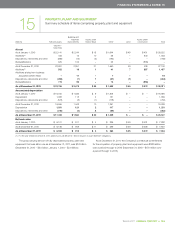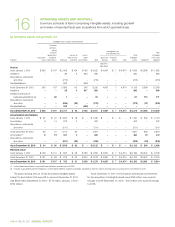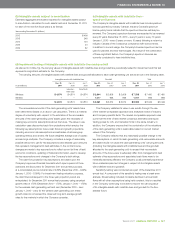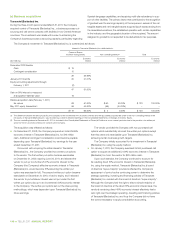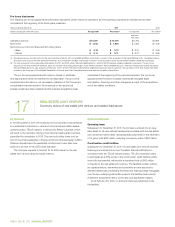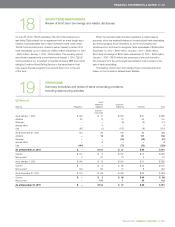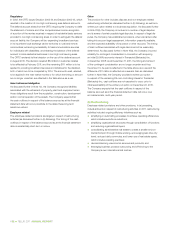Telus 2011 Annual Report Download - page 146
Download and view the complete annual report
Please find page 146 of the 2011 Telus annual report below. You can navigate through the pages in the report by either clicking on the pages listed below, or by using the keyword search tool below to find specific information within the annual report.
142 . TELUS 2011 ANNUAL REPORT
Disaggregation of other defined benefit plan funding status
Accrued benefit obligations are the actuarial present values of benefits attributed to employee services rendered to a particular date. The Company’s
disaggregation of other defined benefit plans surpluses and deficits at year-end was as follows:
As at December 31, 2011 December 31, 2010 January 1, 2010
Accrued Funded status Accrued Funded status Accrued Funded status
benefit – plan surplus benefit – plan surplus benefit – plan surplus
(millions) obligation Plan assets (deficit) obligation Plan assets (deficit) obligation Plan assets (deficit)
Other benefit plan that has plan
assets in excess of accrued
benefit obligations $ß24 $ß24 $ – $ß27 $ß29 $ 2 $ß27 $ß30 $ 3
Unfunded other benefit plans that
have accrued benefit obligations
in excess of plan assets 51 – (51) 48 – (48) 44 – (44)
$ß75 $ß24 $ß(51) $ß75 $ß29 $ß(46) $ß71 $ß30 $ß(41)
Future benefit payments
Estimated future benefit payments from the Company’s other defined
benefit plans, calculated as at December 31, 2011, are as follows:
Years ending December 31 (millions)
2012 $ß 5
2013 5
2014 5
2015 5
2016 5
2017–2021 21
Fair value measurements
As at December 31, 2011 and 2010, the Company had only one other
defined benefit plan and it had only one asset, an experience related
underwriting agreement, which does not have a fair value determinable
by a quoted price in an active market for an identical item.
(d) Plan investment strategies and policies
The Company’s primary goal for the defined benefit pension plans is to
ensure the security of the retirement income and other benefits of the
plan members and their beneficiaries. A secondary goal of the Company
is to maximize the long-term rate of return of the defined benefit plans’
assets within a level of risk acceptable to the Company.
Risk management
The Company considers absolute risk (the risk of contribution increases,
inadequate plan surplus and unfunded obligations) to be more important
than relative return risk. Accordingly, the defined benefit plans’ designs,
the nature and maturity of defined benefit obligations and characteristics
of the plans’ memberships significantly influence investment strategies
and policies. The Company manages risk through specifying allowable
and prohibited investment types, setting diversification strategies and
determining target asset allocations.
Allowable and prohibited investment types
Allowable and prohibited investment types, along with associated
guidelines and limits, are set out in each fund’s required Statement of
Investment Policies and Procedures (SIP&P), which is reviewed and
approved annually by the designated governing body. The SIP&P guide-
lines and limits are further governed by the Pension Benefits Standards
Regulations, 1985’s permitted investments and lending limits. As well as
conventional investments, each fund’s SIP&P may provide for the use
of derivative products to facilitate investment operations and to manage
risk provided that no short position is taken, no use of leverage is
made and there is no violation of guidelines and limits established in
the SIP&P. Internally managed funds are prohibited from increasing
grandfathered investments in securities of the Company; grandfathered
investments were made prior to the merger of BC TELECOM Inc. and
TELUS Corporation, the Company’s predecessors. Externally managed
funds are permitted to invest in securities of the Company, provided
that the investments are consistent with the funds’ mandate and are in
compliance with the relevant SIP&P.
Diversification
The Company’s strategy for equity security investments is to be broadly
diversified across individual securities, industry sectors and geographical
regions. A meaningful portion (20–30% of total plans’ assets) of the
investment in equity securities is allocated to foreign equity securities
with the intent of further increasing the diversification of the plans’ assets.
Debt securities may include a meaningful allocation to mortgages with
the objective of enhancing cash flow and providing greater scope for the
man agement of the bond component of the plans’ assets. Debt securi-
ties also may include real return bonds to provide inflation protection,
consistent with the indexed nature of some defined benefit obligations.
Real estate investments are used to provide diversification of plans’
assets, potential long-term inflation hedging and comparatively stable
investment income.
Relationship between plan assets and benefit obligations
With the objective of lowering the long-term costs of its defined benefit
pension plans, the Company purposely mismatches plan assets and
benefit obligations. This mismatching is implemented by including equity
investments in the long-term asset mix as well as fixed income securities
and mortgages with durations that differ from the benefit obligations.
As at December 31, 2011, the present value-weighted average timing
of obligation estimated cash flows (duration) of the defined benefit
pension plans was 13.6 years (December 31, 2010 – 13.0 years; January 1,
2010 – 13.1 years) and of the other defined benefit plans was 7.0 years
(December 31, 2010 – 7.1 years; January 1, 2010 – 6.8 years).
Compensation for liquidity issues that may have otherwise arisen
from mismatching of plan assets and benefit obligations comes from
broadly diversified investment holdings (including cash and short-term
investments) and cash flows from dividends, interest and rents from
diversified investment holdings.


